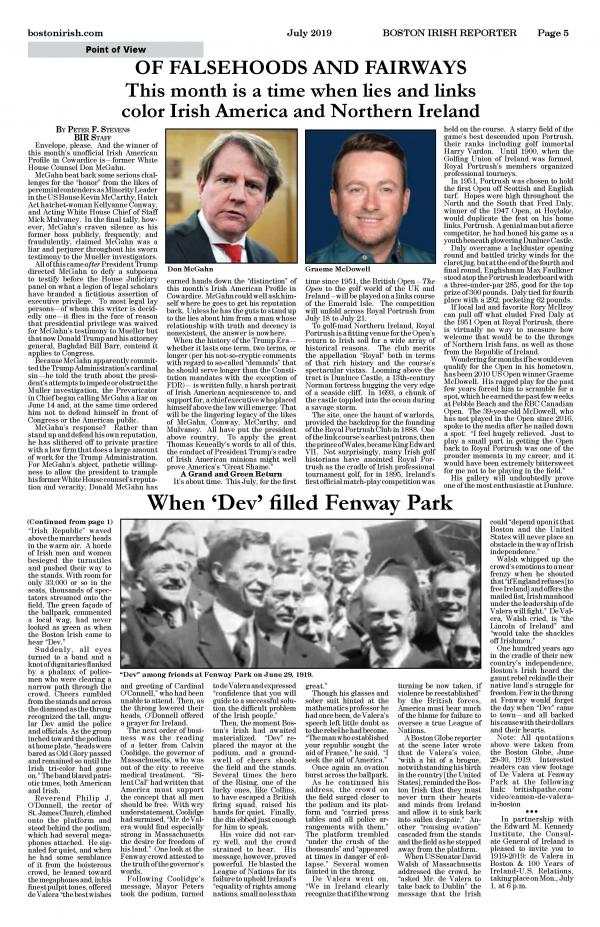June 28, 2019

By Peter F. Stevens
BIR Staff
Envelope, please. And the winner of this month’s unofficial Irish American Profile in Cowardice is—former White House Counsel Don McGahn.
McGahn beat back some serious challenges for the “honor” from the likes of perennial contenders as Minority Leader in the US House Kevin McCarthy, Hatch Act hatchet-woman Kellyann Conway, and Acting White House Chief of Staff Mick Mulvaney. In the final tally, however, McGahn’s craven silence as his former boss publicly, frequently, and fraudulently, claimed McGahn was a liar and perjurer throughout his sworn testimony to the Mueller investigators.
All of this came after President Trump directed McGahn to defy a subpoena to testify before the House Judiciary panel on what a legion of legal scholars have branded a fictitious assertion of executive privilege. To most legal lay persons—of whom this writer is decidedly one—it flies in the face of reason that presidential privilege was waived for McGahn’s testimony to Mueller but that now Donald Trump and his attorney general, Baghdad Bill Barr, contend it applies to Congress.
Because McGahn apparently committed the Trump Administration’s cardinal sin—he told the truth about the president’s attempts to impede or obstruct the Muller investigation, the Prevaricator in Chief began calling McGahn a liar on June 14 and, at the same time ordered him not to defend himself in front of Congress or the American public.
McGahn’s response? Rather than stand up and defend his own reputation, he has slithered off to private practice with a law firm that does a large amount of work for the Trump Administration. For McGahn’s abject, pathetic willingness to allow the president to trample his former White House counsel’s reputation and veracity, Donald McGahn has earned hands down the “distinction” of this month’s Irish American Profile in Cowardice. McGahn could well ask himself where he goes to get his reputation back. Unless he has the guts to stand up to the lies about him from a man whose relationship with truth and decency is nonexistent, the answer is nowhere.
When the history of the Trump Era—whether it lasts one term, two terms, or longer (per his not-so-cryptic comments with regard to so-called “demands” that he should serve longer than the Constitution mandates (with the exception of FDR)— is written fully, a harsh portrait of Irish American acquiescence to, and support for, a chief executive who placed himself above the law will emerge. That will be the lingering legacy of the likes of McGahn, Conway, McCarthy, and Mulvaney. All have put the president above country. To apply the great Thomas Keneally’s words to all of this, the conduct of President Trump’s cadre of Irish American minions might well prove America’s “Great Shame.”
A Grand and Green Return
It’s about time. This July, for the first time since 1951, the British Open – The Open to the golf world of the UK and Ireland – will be played on a links course of the Emerald Isle. The competition will unfold across Royal Portrush from July 18 to July 21.
To golf-mad Northern Ireland, Royal Portrush is a fitting venue for the Open’s return to Irish soil for a wide array of historical reasons. The club merits the appellation “Royal” both in terms of that rich history and the course’s spectacular vistas. Looming above the tract is Dunluce Castle, a 13th-century Norman fortress hugging the very edge of a seaside cliff. In 1693, a chunk of the castle toppled into the ocean during a savage storm.
The site, once the haunt of warlords, provided the backdrop for the founding of the Royal Portrush Club in 1888. One of the link course’s earliest patrons, then the prince of Wales, became King Edward VII. Not surprisingly, many Irish golf historians have anointed Royal Portrush as the cradle of Irish professional tournament golf, for in 1895, Ireland’s first official match-play competition was held on the course. A starry field of the game’s best descended upon Portrush, their ranks including golf immortal Harry Vardon. Until 1900, when the Golfing Union of Ireland was formed, Royal Portrush’s members organized professional tourneys.
In 1951, Portrush was chosen to hold the first Open off Scottish and English turf. Hopes were high throughout the North and the South that Fred Daly, winner of the 1947 Open, at Hoylake, would duplicate the feat on his home links, Portrush. A genial man but a fierce competitor, he had honed his game as a youth beneath glowering Dunluce Castle.
Daly overcame a lackluster opening round and battled tricky winds for the claret jug, but at the end of the fourth and final round, Englishman Max Faulkner stood atop the Portrush leaderboard with a three-under-par 285, good for the top prize of 300 pounds. Daly tied for fourth place with a 292, pocketing 62 pounds.
If local lad and favorite Rory McIlroy can pull off what eluded Fred Daly at the 1951 Open at Royal Portrush, there is virtually no way to measure how welcome that would be to the throngs of Northern Irish fans, as well as those from the Republic of Ireland.
Wondering for months if he would even qualify for the Open in his hometown, has been 2010 US Open winner Graeme McDowell. His ragged play for the past few years forced him to scramble for a spot, which he earned the past few weeks at Pebble Beach and the RBC Canadian Open. The 39-year-old McDowell, who has not played in the Open since 2016, spoke to the media after he nailed down a spot: “I feel hugely relieved. Just to play a small part in getting the Open back to Royal Portrush was one of the prouder moments in my career, and it would have been extremely bittersweet for me not to be playing in the field.”
His gallery will undoubtedly prove one of the most enthusiastic at Dunluce.

